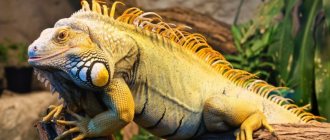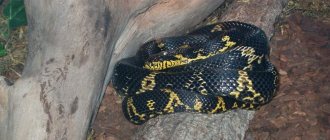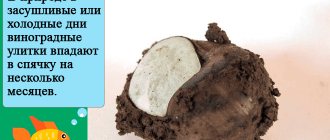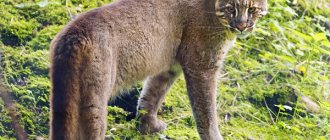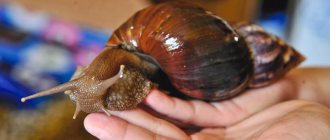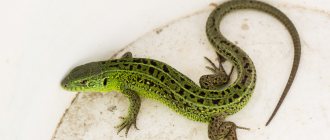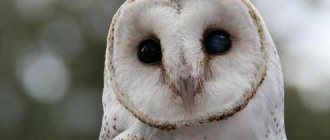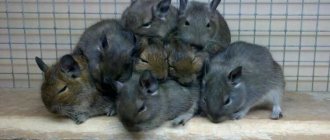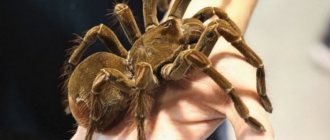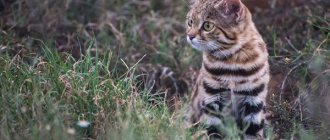The viviparous lizard does not exceed 15-18 centimeters in length, with the tail making up over half of the body. Unlike other species of viviparous lizards, males are always smaller than females.
This species has a modest coloration. Adults are brown, brown, greenish or yellowish-brown above.
Viviparous lizard (Zootoca vivipara).
On the upper side of the body there is a characteristic pattern along the ridge of a dark stripe, which can be interrupted, two wide stripes on the back and wide dark stripes on the sides of the body, bounded below by a light line, sometimes consisting of rounded spots.
There are light and dark elongated spots on the back. In some individuals, the pattern on the back is not pronounced, and sometimes lizards are completely black - melanistic. Black lizards most often live in northern latitudes and in the mountains, this is due to the fact that dark coloring absorbs heat better.
The lower part of the body in males is brick red or orange, in females the belly is yellowish, greenish or whitish-gray. A distinctive feature of males is also a thicker tail at the base. In addition, they have black spots on the lower part of the body.
A distinctive feature of males is their thickened tail at the base.
Newborn lizards have a dark brown or almost black color, often the pattern is not pronounced. As young lizards grow, the color becomes lighter, and a pattern characteristic of adult individuals appears on the main background.
Viviparous lizard - description
These lizards are not distinguished by their bright colors. They are quite modest. In adults, the upper parts of the body and tail may be brown, brown, tan or greenish. It has a characteristic pattern that stretches along the ridge. This is a dark streak that sometimes breaks. In addition, there may be two wide stripes on top and dark stripes on the sides of the body, which are limited by a lower light line, which sometimes consists of rounded spots.
It must be said that not all individuals have a pronounced pattern. Moreover, it is not uncommon for a viviparous lizard (you see the photo in our article) to be completely black. These are melanists. Such animals are most often found in northern latitudes, in the mountains. This color is due to the fact that dark colors absorb heat better.
In males, the lower part of the body is brick-red and even orange; females have a yellowish, greenish or light gray abdomen. In addition, males have a thicker tail at the base.
A viviparous lizard (newborn) has a dark brown, almost black color, often the pattern is not pronounced. Over time, the color becomes lighter, and a characteristic pattern gradually appears on the main background. This happens as the baby grows.
Agamidae
These are medium-sized diurnal lizards, and there are also very small individuals. They live on the ground, in trees, in burrows, in water, and some even fly. They live in Eurasia, Australia and Africa. They live everywhere except very cold areas. Let's look at some species from this family.
- Spinytails chose the northern part of Africa, the Near and Middle East, parts of India and Pakistan. They have a voluminous, wide body up to 75 cm in size. The head has a flattened appearance, the tail is thick and not long, all covered with tuberous spines, for which they got their name. The color is camouflage, the color of dark sand or alumina. A total of 15 species are known.
- Australia and New Guinea are home to Amphibolurinae , all local names of which include the word “dragon” - crested dragon, tropical, forest, bearded (their lower jaw turns black after stress, taking on the appearance of a beard), earless, etc. Most likely, their exotic appearance provoked such nicknames.
Many of them are decorated with spines, and the frilled lizard (Chlamydosaurus) , for example, has a completely menacing appearance. Her head is surrounded by a large fold of skin in the form of a collar, and she raises it like a sail if she is excited. It is about a meter in size, has a fiery terracotta color, and has sharp teeth and claws. All together this creates an eerie impression.
- Moloch, the “prickly devil” (Moloch), looks no less exotic The name itself, in honor of a greedy pagan deity demanding human sacrifices, suggests that this specimen looks frightening. Its entire body is covered with curved spines, and above the eyes these growths look like horns. And he, like a chameleon, can change color. But not as a disguise, but based on my mood and well-being. Only the body size lets us down, it is about 22 cm.
- Water dragons (Phusignathus) stand apart from others They do not live in Australia, but in Southeast Asia, Thailand, Cambodia, Vietnam and China. In Greek, their name means “swollen jaw,” and we know them as Chinese water dragons. They can stay under water for a long time and use their tail to swim. Many people keep these individuals at home.
The following people live in the Russian Federation:
- Caucasian agama (from the genus of Asian mountain), it is capable of inflating its body, huddled in a crack. And it’s impossible to get her out of there, because her whole body is tightly enveloped in small, rough scales.
- steppe agama . This baby, 12 cm long, usually has a camouflage color of gray-olive tones. But in extreme heat or after stress, it changes a lot. And here the gender difference is immediately visible. Males are a rich blue-black color, with azure markings on the back, only the tail takes on an egg yolk hue. And the females are the color of the sky or creamy greenish, with dark orange spots on the back.
- round-headed spinytail is a small lizard up to 14 cm with a tail. Lives in steppe and desert regions (Kazakhstan, Kalmykia, steppes of Stavropol, Astrakhan and Volgograd regions). Its muzzle has a sloping, streamlined shape, which is why it got its name. Very curious, pebbles and other inedible objects are often found in the stomach.
- The takyr roundhead is also an inhabitant of deserts. It has a flat and wide body, a short tail and spotted patterns in blue and pink tones. A distinctive feature is the vertical profile of the muzzle, the upper jaw almost vertically passes into the lip.
- the long-eared roundhead is our “beauty-beast”. In a calm state, it has a quite decent appearance - a patterned grayish-sand color and a not very long tail. But in case of danger, a metamorphosis occurs - it takes a threatening pose, tenses, spreads its legs, and puffs up. Then it opens its bright pink, toothy mouth, expanding it with protective folds, like large ears. An angry hiss and a curled tail complete the action, forcing the enemy to flee.
Habitat
These cute lizards inhabit almost the entire forest territory of Eurasia - from Ireland, Great Britain and the Pyrenees to Sakhalin, Kolyma and the Shantar Islands. In the west of their range they are distributed from the Kola Peninsula to the Arctic Circle and the lower reaches of the Yenisei. Viviparous lizards live everywhere on Sakhalin, and in the south they can be found in the forest zone.
The viviparous lizard prefers to settle on the edges, in thickets of bushes along the banks of rivers and lakes, and in clearings. They can often be found in wet floodplain meadows that border the forest. In Siberia, they can also live in the tundra, in swampy areas on hummocks, surrounded on all sides by water. Shelters for these lizards include dense forest litter, burrows of small rodents, shallow crevices between stones, and old, dilapidated stumps. Viviparous lizards do not build their own shelters.
Masks
A monotypic family found in the West Indies and Florida. They are able to curl their tail into a spiral. They got their name from the wide black stripe that runs from the nose through the eyes. The most typical of this family is the common masked iguana, which lives in Haiti.
Lifestyle
Probably not everyone knows that the viviparous lizard is not only an excellent swimmer and diver, it also moves easily along the bottom of a reservoir. If she is in danger, she instantly buries herself in the mud. Lizards of this species do not run very well when compared with their large green counterparts.
In mountainous areas they often live at altitudes of up to 2500 meters. They feel great in a humid environment and tolerate fairly low temperatures. Thanks to this feature, they were able to settle in the Arctic Circle, where in winter they hibernate.
In the spring, when the air warms up to only + 4 degrees, and there is still snow in some places, they come out of this state. At this time, they bask in the sun for a long time, hiding in holes in the ground, on boards, and stumps. Normal activity returns to them when the air warms up above +15 degrees.
In the central regions of Russia they finish wintering at the end of March, in the Far East - at the end of May, and in the north - at the beginning of June.
Collared
Inhabitants of North America. They do not have many typical features of the infraorder Iguanaiformes - a longitudinal ribbed stripe on the back, a throat pouch, a rostral shield, spines and growths, scales on the ears and fingers. Therefore, they were taken out of the iguana family, elevated to the rank of their own family. A distinctive feature is the presence of a colorful, bright collar.
We will equip a terrarium
Your pet will need a small horizontal terrarium. For one individual, its minimum dimensions must be 30×20×20 cm. A certain temperature must be maintained in it. This is achieved using a thermal cord, a thermal stone, a thermal mat, or thanks to heating lamps - incandescent lamps, mirror lamps directed downwards.
A viviparous lizard at home needs a warm corner, in which the temperature during the day should be up to 30°C, and at night at least 20°C. In indoor conditions, night heating is not necessary. Place a piece of driftwood, a wooden shelf or a stone slide under the lamp so that your pet can warm up well, choosing a more comfortable temperature.
The terrarium must have a small drinking pond; lizards love to swim and do it with pleasure. Shelters can be built in any shape - these can be shelves, houses, stone slides, etc. It is better to use coarse sand, gravel, or coconut substrate as soil. Once a day, the terrarium should be sprayed with warm water. This will maintain the necessary humidity. You can keep lizards in a group.
Scalefoot
Legless reptiles, very similar to snakes. However, they do not make hissing sounds, but clicking sounds. The largest ones grow up to 1.2 m, the small ones – up to 15 cm. They range from straw to peat in color. They live mainly in Australia and New Guinea. The infraorder skinks also includes 7 families
Daily and seasonal rhythms
Daylight hours and operation of daytime heating systems vary throughout the year. When the animal is active (autumn, spring, summer), it is 12 hours. For irradiation it is more advisable to use erythema lamps. The session is five minutes three times a day. You can carry out this procedure with household appliances (UFD) for 1 - 2 minutes during the week. When irradiating with any type of device, the animal must be in a dry area.
In winter, lizards need complete rest. Over the course of three weeks, you should very slowly reduce the duration of heating and reduce daylight hours. When it reaches six hours, the heating is turned off, and the viviparous lizard does not receive food. Keeping in captivity involves placing it after a week in a ventilated, light-proof cage, which is filled with sawdust or pressed sphagnum. During wintering, the temperature should be maintained at 8-10°C. We must not forget about humidity. It should be maintained by spraying the soil in the corner of the cage once a week. The duration of wintering is about two months. The lizards are brought out of this state in the same rhythm, gradually increasing the heat and daylight hours. When the six-hour day is reached, the heating is turned on and the animal begins to be given food.
Corytophanidae
They live in central North and northern South America. They are called helmet or casque-headed for the special structure of the head and for the ridge that goes to the tail. There are several basilisks among them. It is unknown why they were named after a mythical creature with a freezing gaze.
Perhaps for the ability to look for a long time without blinking. Or maybe for the ability to run on water, quickly moving its paws. At the same time, they can reach speeds of up to 12 km/h. The remaining families in this infraorder also live in America. The next infraorder - Gecko-like - contains 7 families.
Feeding
Under natural conditions, viviparous lizards feed on small invertebrates, sometimes they eat their young. In a terrarium, they are fed mealworms, crickets, cockroaches, zoobass, and other insects. They willingly eat earthworms, small snails and newborn mice. Feeding is done at least once every two days, but you can feed it daily. There should be fresh water in the drinking bowl at all times.
Do not neglect the various mineral supplements that are given along with the food - crushed eggshells, preparations with a high calcium content. You can periodically add “Borjomi” mineral water to the drinking bowl. Give your pet concentrated vitamin preparations once a week.
Gecko
All geckos are distinguished from other lizards by their karyotype (an individual set of chromosome characteristics), as well as a special muscle in the ear area. They do not have bony temporal arches. In addition, most geckos have prehensile and long toes covered with fine hairs.
This allows them to move along any vertical surface. Looking at the types of lizards in the photo , you can immediately recognize the gecko. They are often photographed on glass and even on the ceiling. A small gecko weighing up to 50 g is capable of holding a load weighing up to 2 kg.
The following people live in the Russian Federation:
- squeaky gecko , a small 8-centimeter inhabitant of the area near Mount Bolshoi Bogdo in the Astrakhan region, allocated to the Bogdinsko-Baskunchaksky Nature Reserve. Listed in the Red Book. The length of the body is equal to the length of the tail - all about 4 cm. Covered with granular scales. Painted in light ocher tones with a dusty coating, the belly is light. There are at least five wide transverse coffee-colored stripes on the back.
- Caspian gecko or thin-toed gecko. There are island and main subspecies. Active both day and night. Loves rocky places, hides in rodent burrows.
- gray or bare-toed gecko Rousson , we live in Kazakhstan and Ciscaucasia. A very small specimen, including the tail, it is 5 m in length.
Reproduction
At the age of two years, viviparous lizards become sexually mature. There are ovoviviparous and oviparous species. They lay eggs in the Cantabrian mountains. This happens twice a season. Incubation lasts approximately forty days at a temperature of about 18-20°C.
At other points, viviparous lizards give birth to babies in a mucous, transparent egg shell, which the small lizards tear apart within thirty minutes.
After leaving the hibernation (at home), the lizards are irradiated and fed with regular food. But drugs containing vitamin E are added to it. This lasts 3 weeks. Then the lizards molt, and the males acquire a “nuptial” coloration. After this, males and females are combined in one terrarium, if they were kept separately.
Copulation lasts no more than five minutes. The female's pregnancy lasts from 70 to 90 days. Usually from 2 to 12 babies are born.
Anolis
Inhabitants of America and the Caribbean Islands. They have a small slender body, most often the color of young or withered grass, and long fingers. Males have a scarlet throat sac, which is inflated and protruded during the mating season or at times of danger. Because of this, many of them are called red-necked. May change color depending on condition.
Skinks
They live everywhere except Antarctica. They have smooth fish-like scales. The temporal arches are well developed. Among them there are such striking representatives as blue-tongued skinks - gigantic or tiliqua. They live in Australia and the islands of Oceania.
Their size is not so impressive - up to 50 cm. But the body is very wide and powerful. An individual touch is a wide tongue of deep blue color. Perhaps these are the consequences of the diet. They prefer to eat shellfish and plants.
Among skinks, there are species with unusual eyes - with a transparent window on the lower eyelid. They always see, even when they close their eyes. And gologlaz have transparent eyelids fused together, like snakes. These “lenses” allow them to absolutely not blink.
Members of the family represent a smooth transition to legless forms - from normally developed limbs and five fingers to shortened and reduced variants, and finally, completely legless. There are short-tailed, prehensile-tailed and spiny-tailed species, as well as semi-aquatic, floral and desert species.
In the Russian Federation live:
The long-legged skink is found in Central Asia, Eastern Transcaucasia and southeast Dagestan. Up to 25 cm in size, movable eyelids, very brittle tail. The color is brownish-olive with grey. Bright and variegated longitudinal stripes are visible on the sides.
Far Eastern skink, resident of the Kuril and Japanese islands. Olive-gray in color with a bluish-pearl long tail. Included in the Red Book of Russia.
Fusiformes – 3 families
Veretenitaceae
Among them there are crawling, snake-like ones, and ordinary ones - on four five-toed paws. All scales are supported by bone plates called osteoderms. Some have stretchable folds of skin on their sides, which make it easier for them to breathe and swallow food. Unlike snakes, they have movable eyelids and auditory openings. The jaws are strong, the teeth are dull. There are viviparous species.
In the Russian Federation live:
- The brittle spindle or slow spindle is a legless lizard up to 50-60 cm long. Its shape resembles a spindle. The color is reddish-gray or brown, or bronze-copper, for which it received its second name.
- The yellowtail or capercaillie is also a legless lizard. Or rather, there are still hind limbs, but they represent very small tubercles near the anus. It can reach 1.5 m in length. The head is tetrahedral, with a pointed muzzle. The color is olive-gray with brick tones.
Monitor lizards - now there are 3 families left
Geckos
These are small, but very active and funny lizards. Thanks to the special design of their legs, they can run on any surface - from floor to ceiling.
Such reptiles are very famous for their love of climbing walls, no matter how smooth they are. This becomes possible due to the presence of a large number of microvilli and growths on their short limbs.
Therefore, you should always keep nimble domestic lizards in sight, especially until the period of adaptation to the new environment ends.
The size of the reptile can vary from 1.5 to 35 centimeters. You can easily recognize a gecko by its appearance.
Such lizards have a flattened body, very small legs, a long thick tail and a disproportionately large head.
It is by the appearance of this part of the body that one can learn a lot about the reptile’s way of life and nutrition (it is in this section that fat and water from the entire body accumulate).
The second feature of this breed is the absence of eyelids on the eyes, therefore, in order to avoid drying out the eyes, the gecko has to lick them from time to time. These small reptiles live on average 15-20 years.
Monitor lizards
The largest of them, undoubtedly, is the famous Komodo dragon. The recorded maximum size of its body is 3.13 m. The smallest is the short-tailed Australian monitor lizard with a body length of up to 28 cm. Monitor lizards have a completely ossified skull, an elongated body, a neck, and a forked tongue.
They walk on almost straightened limbs. The head is covered with polygonal bony scutes. They live in Asia, Australia and Africa. They prefer a diurnal lifestyle, with the exception of a few species - dark, striped and Komodo monitor lizards.
The latter exhibited parthenogenesis (same-sex reproduction). That is, females can give birth without males, their eggs develop without fertilization. All monitor lizards are oviparous. Dibamia -1 family.
Vermiforms are earless, eyeless and legless creatures that live in the earth. They dig tunnels and are very similar to earthworms. They live in the forests of Indochina, New Guinea, the Philippines and Mexico. Superfamily Shinisauroidae with one family.
The crocodile shinisaurus lives in southern China and northern Vietnam. Body length is about 40 cm. Currently, domestic species of lizards are increasingly decorated with this species. Special methods for breeding it in a terrarium have been developed.
Diseases
Fire-bellied newts are hardy animals. They have good health and are little susceptible to disease.
| Factors causing diseases | ||
| Errors in care | Injuries | Diseases, stress |
| Unsuitable physical and chemical characteristics of water | Sharp aquarium elements | Bending |
| Insufficient hygiene of the aquaterrarium | Frequent contact with human hands | Parasites |
| Unbalanced diet | Aggressive, incompatible neighbors | Infections |
| Poor quality food | Incompatible species | |
Most often, Chinese newts are susceptible to fungal and bacterial diseases. The source of pathogens may be other sick animals in the aquarium or infected food. Unhealthy individuals should be immediately removed from the common tank.
The presence of diseases may be indicated by:
- Poor appetite.
- Long stay on land.
- Loss of coordination.
- Plaque, ulcerative lesions, wounds and scabs on the skin.
- Cloudy eyes.
- Swelling of part of the body.
- Lethargy.
Veterinary clinics cannot always diagnose the disease; this requires laboratory equipment. Therefore, specialists practice complex treatment, immediately against all factors provoking the disease.
The following drugs are usually combined:
- Antifungal - nystatin.
- Antimicrobial - ciprofloxacin or trichopolum.
For treatment, take one tablet of the drug from each group, dissolve it in a small amount of water and the resulting solution is diluted in a 10-liter tank.
Open wounds are disinfected with antiseptics, and Melafix (a natural broad-spectrum remedy) is added to the water.
Important!
Newly purchased animals must be quarantined and regularly inspected before being added to a community aquarium. This will prevent mass infection if the animals turn out to be unhealthy.
Reviews
Chinese newts are not the most common inhabitants of aquariums, but this is what makes them interesting. Their way of life and special habits are not typical of traditional animals that are usually kept in an aquarium. A small corner of wildlife recreated at home with extravagant newts will give you many new emotions with these inhabitants of the aquatic ecosystem.
Would you like to purchase a newt for your own aquaterrarium? Share in the comments!
Earless monitor lizards
They live in Borneo (Kalimantan). The color is reddish-brown, with brown longitudinal stripes. The tail is long and narrow, making up half the length of the entire half-meter body. There is no external ear opening. This is a very rare species of lizard . Now there are no more than 100 individuals left.
